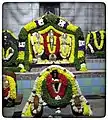Sudi | |
|---|---|
Panchayat town | |
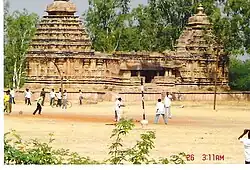 Twin Towered Temple at Sudi | |
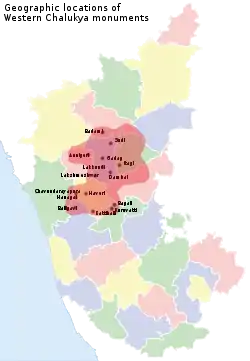 | |
| Country | India |
| State | Karnataka |
| District | Gadag |
| Area | |
| • Total | 5.3 km2 (2.0 sq mi) |
| Elevation | 586 m (1,923 ft) |
| Population (2001) | |
| • Total | 6,000 |
| • Density | 1,100/km2 (2,900/sq mi) |
Sudi, is a panchayat town in the Gadag District of Karnataka, India. It is about 30 km from Badami, 12 km from Gajendragad and 3 km from Itagi Bhimambika temple. In the past it was an important town of the Kalyani Chalukyas during 1000 AD. It is notable for rare stone carved monuments like Twin towered temple, Mallikarjuna temple and nagakunda (large well built of stone and carvings), and few other structural temples. For long time these structures were abandoned, but recently they caught the eye of the Indian Archaeological Department (ASI - Archaeological Survey of India).
History
Sudi belongs to the core area of Western Chalukya architectural activity in modern Karnataka (particularly North Karnataka).
Padevala Taila (son of Nagadeva), continued to serve under Satyashraya (succeeded his father Taila in 997 AD) and his mother Attiyabbe made a grant in 1005 A.D. Satyashraya had two daughters. Vradhamabbarasi and Akkadevi and one son Kundin (Kundiraja). Akkadevi was a good administrator[1] and was governing some division during the time of Satyashraya and his successors. Kundiraja was placed in charge of divisions like Banavasi 12,000 and Santalige 1,000.
Akkadevi and Kundin, continued to govern (dating 8_October_1013 AD) some provinces of the Chalukya Empire during the reign of Vikramaditya.
Sudi was the capital of the Kalyani Chalukyas in 1100 AD.[2][3] Kalyani Chalukyas king's daughter Akkadevi ruled the place. There are also historical records indicating that coins were manufactured (mint)[4] in this town during that time.
Coinage
During Western Chalukyas (973 – 1189 south), The Alupas, a feudatory, minted coins with the Kannada and Nagari legend Sri Pandya Dhanamjaya. Lakkundi and Sudi in Gadag district were the main mints[5] (Tankhashaley) . Their heaviest gold coin was Gadyanaka (weighed 96 grains), Dramma (weighted 65 grains), Kalanju (48 grains), Kasu (15 grains), Manjadi (2.5 grains), Akkam (1.25 grains) and Pana (9.6 grain).
Shaivism, Pasupata school
Shaivism gained importance and Jainism lost towards the closing years of the Chalukya rule. Shaivism was dominant, and had several sects like Shaiva, Pasupata or Lakula, Kalamukha and Kapaliaka. The Pasupata school was important and had important centers at Balligavi, Sudi,[6] Srisailam and other places.
Inscriptions
The Cholas claim to have captured a large number of Chalukya feudatory princes with their women and sacked and burnt Mannandippai. The Chalukya reverses are admitted in a Sudi inscription,[1] dated in 1050 A.D., of the reign of Someshvara. It says that the 7 ministers granted the settis renewal of their corporate constitution (which had partly broken down in the stress of the war with the Cholas).
The Chola king was killed at Koppam, but the Chalukyas were also pushed back from there by Rajendra. Soon after the Chalukyas raided Kanchi, the Chola capital, burnt the city and defeated the Cholas once again. A Sudi inscription (Thursday, 20_January_1060 AD), records that king Trailokyamalla was halting at his camp Puli, a town within Sindavadi division after having made a victorious expedition to the southern region and conquered the Chola.
Sudi has several stone temples built by Maha Samanthadhipati Naga Deva in 1100 AD that have caught the attention of the Karnataka State Archeological Department. Quite a few of these structures have been cleaned up. Besides age-old structures there is also a tower (called Hude in native language) located in the center of the village. The richness of these temples can be viewed in the images posted here.
Tourism
Twin Towered Shiva Temple
Twin Towered, Two Vimana, Jodakalasa Temple[7][8]
Later Chalukya monument, Before 1059-60, by Nageshwara by General Nagadeva administering Sudi.
Shri Chidambara Panchangam
Chidambara Panchanga is publishing from Sudi for many years. It was started by Late.Vedabrahma Shri Ramashastri Joshi.
Shri Shiva Chidambareshwara temple
Adjacent to the Shri Shiva Chidambareshwara temple there is a 29-feet Lord Shiva statue in a standing position which is rare in India & it was inaugurated by Shri Vishwesha Tirtharu, Pejawara Matha, Udupi.
Mallikarjuna Temple
Mallikarjuna temple[9] at Sudi is a later Chalukya (Kalyani Chalukyas) monument, 1054, Founded under princess Akkadevi Governor of Sudi
Naga Kunda (Well)

Nagakunda literally means King cobra tank at Sudi is a carved (Inner wall) temple tank.
This is totally neglected by the people, ASI and Govt. of Karnataka. There is need of immediate conservation work to protect this monument.
Other monuments at Sudi
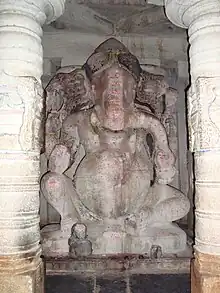

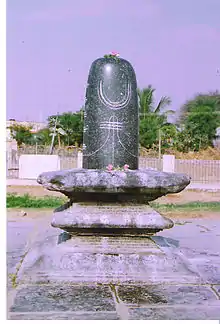
- Large Ganapati Statue
- Ishwara Linga in a stone made shelter
- Large Shiva linga
- Hude (Tower)


Other monuments at Sudi include a large Ganapati Statue and Nandi statue inside mantapa and a large Shiva linga.
Geography
It has an average elevation of 586 metres (1,923 ft). It is located adjacent to 2 streams called Hirehalla and Doddahalla and has total area of the town is 5.3 square kilometres (2.0 sq mi).
It is located 120 kilometres (75 mi) from Karnataka, 42 kilometres from Gadag and 450 kilometres from Bangalore, the state capital.
Climate
The temperature ranges from minimum 23 degrees to 45 degrees during summer and from 15 to 29 degrees in winter. The rainfall of the area is 50 centimeters. Best time to visit is between low humid season from November and March.
Transport
The nearest airport is Hubli about 100 kilometres away. It is east of Hubli-Sholapur rail route, and the rail station (Mallapur) is 25 kilometres from the town. It is also connected by road to Hubli and Gadag. Sudi is reachable from Bangalore by a 12-hour bus ride, or with a combination of an overnight train journey from Bangalore to Ron followed by a short bus ride from Ron to Sudi.
Demographics
As of 2001 India census,[10] Sudi had a population of 6,000. Males constitute 51% of the population and females 49%. Sudi has an average literacy rate of 65%, higher than the national average of 59.5%; with 59% of the males and 41% of females literate. 14% of the population is under 6 years of age.
See also
Notes
- 1 2 "Chapter 9. The Calukyas and the Kalacuryas of Kalyani. History – Ancient Period, Chalukya" (PDF). Retrieved 10 March 2009.
- ↑ "No. 15, RON INSCRIPTION OF TURiGAVEDENGA. 387, The Bali-vamsa is mentioned again in an inscription of A.D. 1113 or 1114 at Sudi". Manager of Publications,Delhi. Retrieved 9 March 2009.
- ↑ "Sudi". Retrieved 9 March 2009.
- ↑ "south indian inscriptions, introduction2, mint at sudi". Retrieved 9 March 2009.
- ↑ "Indian coinage, Western Chalukyas 973 – 1189 south". Retrieved 9 March 2009.
- ↑ Ancient Indian History and Civilization. By Sailendra Nath Sen. 1999. ISBN 9788122411980. Retrieved 9 March 2009.
- ↑ Hardy, Adam (1995). Indian Temple Architecture By Adam Hardy, Sudi. ISBN 9788170173120. Retrieved 14 November 2008.
- ↑ "List of monuments in India, Sudi". Archived from the original on 1 December 2008. Retrieved 9 March 2009.
- ↑ "Karnataka Temples". Retrieved 9 March 2009.
- ↑ "Census of India 2001: Data from the 2001 Census, including cities, villages and towns (Provisional)". Census Commission of India. Archived from the original on 16 June 2004. Retrieved 1 November 2008.
References
- Sudi Kalanelege kayakalpa, Dr. D. V. Devaraj, Director, Karnataka State Archeology, Mysore, publication in Sudha Magazine
